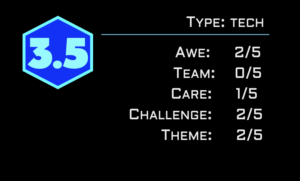
Review by Michael
 “Ex–Machine” is a time-travel themed escape room located in Redmond, a chic suburb of Seattle, and housed within the Conundroom venue. It boasts high-tech equipment, dazzling lights, and futuristic sound effects. While the room was visually impressive (with a large, ostensibly interactive Time Machine as its centerpiece) functionality was a challenge. A key task involving laser sensors proved dysfunctional, initially leading us to question our understanding of the task rather than the equipment’s reliability. Well, the problem wasn’t us. By the time we’d established that, valuable time had been wasted. Your mileage is not likely to vary.
“Ex–Machine” is a time-travel themed escape room located in Redmond, a chic suburb of Seattle, and housed within the Conundroom venue. It boasts high-tech equipment, dazzling lights, and futuristic sound effects. While the room was visually impressive (with a large, ostensibly interactive Time Machine as its centerpiece) functionality was a challenge. A key task involving laser sensors proved dysfunctional, initially leading us to question our understanding of the task rather than the equipment’s reliability. Well, the problem wasn’t us. By the time we’d established that, valuable time had been wasted. Your mileage is not likely to vary.
There were other problems, but they were all really just one root problem: the gizmos. Overall, we experienced an inversion of the normal appeal of complex machines. Generally, we expect big machines to accomplish tasks that smaller ones cannot. In this high-tech room, we often wished we were using more primitive (or “normal”) tools. For example, in one task, we had to use a gizmo to get to a certain year. Had the lasers been used to match recognizable objects to the decade they came from, we would have found it an intriguing, technologically advanced task. Yet, the actual task was simply entering a digit between 1 and 9. It felt like an unnecessary complication for a task that could have been achieved more simply and more meaningfully. The room was trying to avoid “the obvious”, but the designers forgot that machines are tools, and to an extent, they have to be obvious. We’re meant to imagine that somebody used these tools regularly. The arcane part, once figured out, has to make sense, and has to make the player think “oh, I see why they do it this way”. An excellent source for ideas for this kind of puzzle is the video game Myst (and its sequels). Its puzzles are usually “machines without manuals” (according to Cyan software, unless I misremember)
Many non-enthusiasts would say, “so what? You know it’s a game, right?” But the argument that “this is just how escape rooms are” doesn’t hold up. Yes, many escape rooms over-complicate simple tasks, but it doesn’t make for a quality experience. A few interesting toys, embodying puzzles based in irrelevant math and an ambiguous way of giving the player feedback, were a welcome distraction from the room’s plot (whose details were not clear to us).
—
Conundroom
16261 Redmond Way, #150, Redmond, WA, 98052
(425) 906-1094
More posts from:
August 2023 / All of 2023